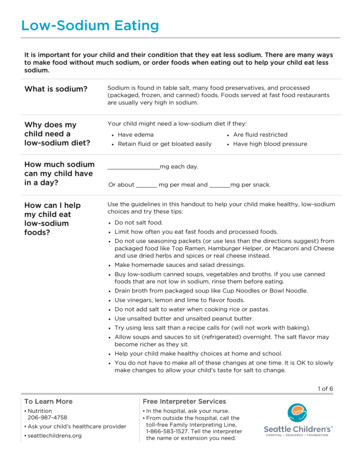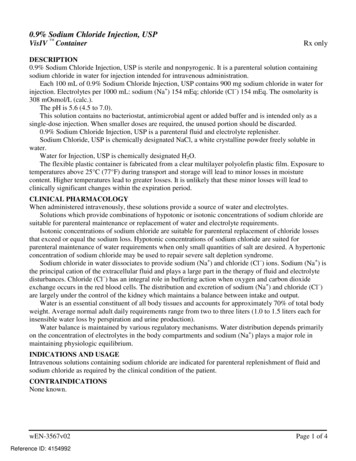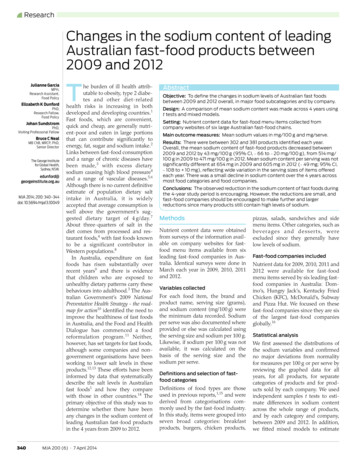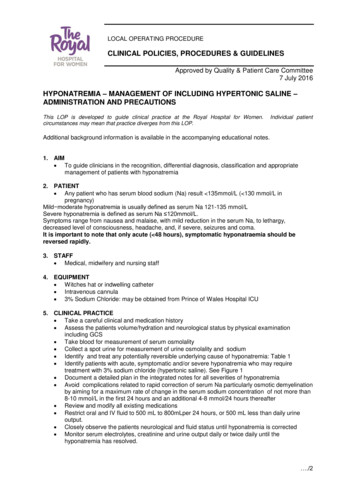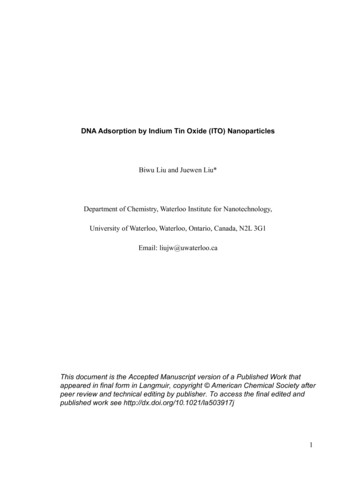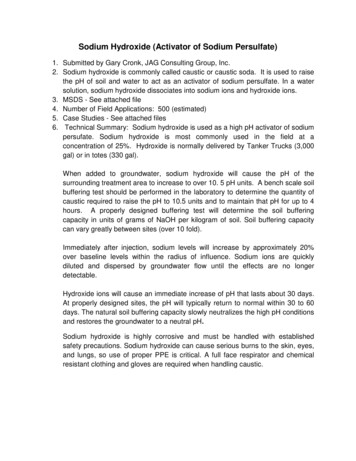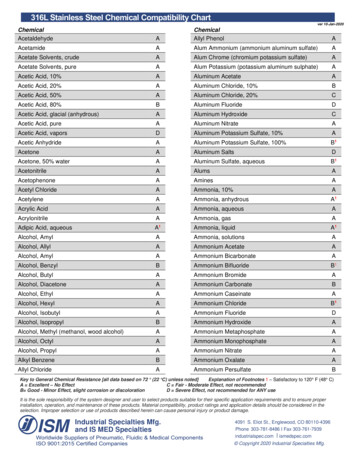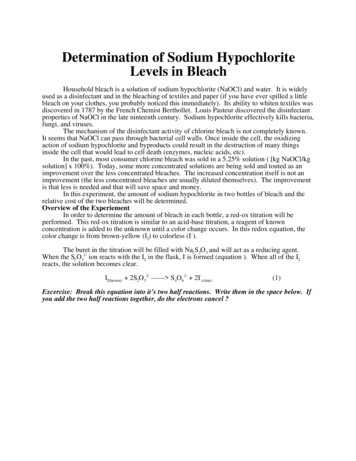
Transcription
Determination of Sodium HypochloriteLevels in BleachHousehold bleach is a solution of sodium hypochlorite (NaOCl) and water. It is widelyused as a disinfectant and in the bleaching of textiles and paper (if you have ever spilled a littlebleach on your clothes, you probably noticed this immediately). Its ability to whiten textiles wasdiscovered in 1787 by the French Chemist Berthollet. Louis Pasteur discovered the disinfectantproperties of NaOCl in the late ninteenth century. Sodium hypochlorite effectively kills bacteria,fungi, and viruses.The mechanism of the disinfectant activity of chlorine bleach is not completely known.It seems that NaOCl can pass through bacterial cell walls. Once inside the cell, the oxidizingaction of sodium hypochlorite and byproducts could result in the destruction of many thingsinside the cell that would lead to cell death (enzymes, nucleic acids, etc).In the past, most consumer chlorine bleach was sold in a 5.25% solution ( [kg NaOCl/kgsolution] x 100%). Today, some more concentrated solutions are being sold and touted as animprovement over the less concentrated bleaches. The increased concentration itself is not animprovement (the less concentrated bleaches are usually diluted themselves). The improvementis that less is needed and that will save space and money.In this experiment, the amount of sodium hypochlorite in two bottles of bleach and therelative cost of the two bleaches will be determined.Overview of the ExperiementIn order to determine the amount of bleach in each bottle, a red-ox titration will beperformed. This red-ox titration is similar to an acid-base titration, a reagent of knownconcentration is added to the unknown until a color change occurs. In this redox equation, thecolor change is from brown-yellow (I2) to colorless (I- ).The buret in the titration will be filled with Na2 S2O3 and will act as a reducing agent.When the S2 O32- ion reacts with the I2 in the flask, I- is formed (equation ). When all of the I2reacts, the solution becomes clear.I2(brown) 2S2O3 2- ------ S 4O6 2- 2I-(clear)(1)Excercise: Break this equation into it’s two half reactions. Write them in the space below. Ifyou add the two half reactions together, do the electrons cancel ?
So where did the I2 come from?Reacting the bleach directly with the S2 O32- solution would result in reduction of the OClto Cl according to equation 2. As you can see, bothOCl-(faint yellow) 2S 2O32-colorless) ---- Cl- (colorless) S 4O62-(colorless) (2)solutions are mostly colorless. It would be difficult to see the transition from faint yellow tocolorless. For this reason, the bleach solution is added to an I- solution (equation 3)OCl- 2I-(clear) ---- I2(brown) Cl-(3)So 1.00 mole of bleach results in the formation of 1.00 moles of I2. According to equation 1,0.500 moles of I2 then reacts with 2.00 mole of S2 O3 2-. The result is that for 1.00 mole of OCl- inthe flask, 2.00 moles of S2O32- are required to reach the endpoint.Sample Calculation.Assume you added 1.00 mL of bleach to the I- solution in an Erlenmeyer flask. Theinitial reading on the buret of S2 O32- is 0.15 mL and the final reading is 35.45 mL. The volumeof S2 O3 2- solution is :35.45 mL - 0.15 mL 35.30 mL (or 0.03530 L)(4)If the concentration of the S2O32- solution is 0.250 M, the amount of S2O3 2- used is0.03530L 0.250moles 8.83 10 3 moles1L(5)But what is needed is the concentration of OCl-. For every one mole of OCl-, two moles of S 2O32is required, so1moleOCl -2(8.83 x 10-3 moles S 2O32-)x2 1.77 x 10 moles OCl2molesS2O3Because 1.0 mL (0.0010 L) of OCl- solution was initially added (what came from the bottle):1.77 10 2 molesOCl concentration of OCl solution 17.7 M OCl0.0010L-ExperimentalThe solutions used include: Two types of bleach (one normal and one ‘concentrated”) An acidic I- solution prepared from 6.3 g of NaI (or 7.0 g of KI) and 20 mL glacial acetic aciddiluted to 1L with water A 0.100 M solution of Na2S2O3Part 1.To begin the titration, wash out the buret first with water. After you have drained thewater out, add 5 mL of the Na2S2O3 solution to the buret and twist the buret while pouringslowly to allow the Na2 S2 O3 to contact the entire inner surface of the buret.
Figure 1. The buret with funnel for filling.Make sure the stopcock is closed (perpendicular to the buret) and fill the buret close tothe 0 mL mark (but not above) with the Na2S2O3 solution. With a beaker under the stopcock,drain some of the solution out the stopcock until the air bubbles in the tip are gone (you mayneed to add a bit more Na2 S2O3 to the buret afterwards),
Figure 2. Buret tip with bubble, and without bubbleAdd 50 mL of the acid/I- solution to a 125 mL Erlenmeyer flask or 250 mL beaker. Add1.0 mL of your bleach to flask as well. When the bleach is added, the solution should turnbrown.(before)(after)Figure 3. Iodide solution before addition of bleach and after addition of bleachRecord the initial volume of the S2 O3 2- in the buret. Slowly add the S2O3 2- solution to the
bleach in the flask or beaker. After you each mL or so, stop and swirl the solution. Do not addthe solution too quickly (but you don’t need to add it drop by drop yet). The color of the iodinewill get lighter and lighter. You will need to add the solution dropwise as the solution becomesvery light. You should see the color completely disappear in one drop.(a)(b)Figure 4. Titration soution two drops before the endpoint (a) and at the endpoint (b)
Calculations(1) Record the volume of the buret at the endpoint.(2) Subtract the initial volume from the final volume to determine the volume of Na2 S2 O3 used(3) Using the concentration of the Na2S2O3 (given by your instructor), determine the number ofmoles of S2O3 2- used.(4) Determine the number of moles of NaOCl that were in the flask or beaker (see samplecalculations above)(5) Using the volume of bleach you added to the flask or beaker, determine the concentration ofthe NaOCl in the bleach.Part 2. Repeat the steps in part 1 with the other bleach.Part 3. ComparisonUsing the molarity of the two bleaches (from parts 1 and 2) determine the number ofmoles of NaOCl in each of the bleach bottles (when full). Using the formula weight of NaOCl,determine the mass of NaOCl in each bottle. If you have the price of the two bottles, divide theprice for each bottle by the number of moles of NaOCl in each bottle (you units should be /mole). Which bottle is cheaper? Is the concentrated bleach a good buy? Are there anyhazards to using the more concentrated bleach?This experiment was developed by Michael R. Jordan at Oklahoma Baptist University . Reproduction for academic use ispermitted.
Calculations (1) Record the volume of the buret at the endpoint. (2) Subtract the initial volume from the final volume to determine the volume of Na 2 S2 O 3 used (3) Using the concentration of the Na 2S 2O 3 (given by your instructor), determine the number of moles of S 2O 3 2-used.(4) Determine the number of moles of NaOCl that were in the flask or beaker (see sample

